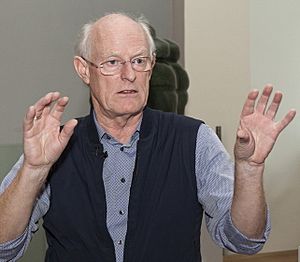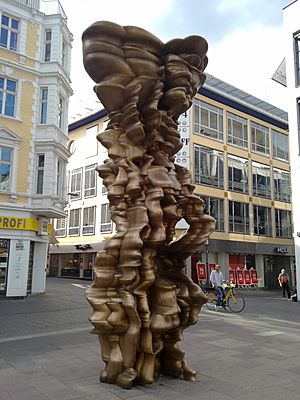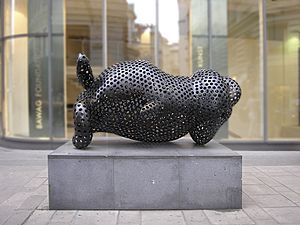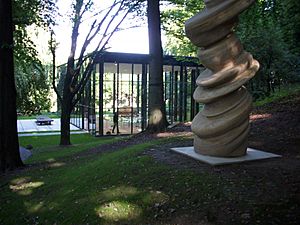Tony Cragg facts for kids
Quick facts for kids
Sir
Tony Cragg
|
|
|---|---|

Cragg in 2016
|
|
| Born | 9 April 1949 Liverpool, England, UK
|
| Nationality | German and British |
| Known for | Sculpture |
| Spouse(s) | Tatjana Verhasselt |
| Awards | Turner Prize (1988) Grand Cross 1st Class Order of Merit of the Federal Republic of Germany (2012) |
| Elected | Royal Academy |
Sir Anthony Douglas Cragg is a famous sculptor. He was born in Liverpool, England, on April 9, 1949. Since 1977, he has lived in Wuppertal, Germany. He is known for creating amazing sculptures from many different materials.
Contents
Tony Cragg's Early Life and Art Training
Tony Cragg grew up in Liverpool. His father worked as an aerospace engineer. After high school, Tony first worked as a lab technician.
He then decided to study art. From 1968 to 1970, he went to the Gloucestershire College of Arts and Technology. He also studied painting at the Wimbledon School of Art in London. In 1973, he began studying sculpture at the Royal College of Art in London. He finished his master's degree in 1977.
Tony moved to Wuppertal, Germany, in 1977. His first wife was from there. He also found affordable art studios and people who wanted to show new artists' work. He was very interested in how important sculpture was in Germany.
Tony Cragg is married to artist Tatjana Verhasselt. He has four children.
Tony Cragg's Sculpting Career

In his early work, Tony Cragg often used everyday objects and discarded materials. He would arrange these items to create art.
From the mid-1970s to the early 1980s, he made sculptures from many pieces. He often used colorful materials. He would arrange them on floors or walls to form larger pictures. An example is his 1975 piece called Stack. Another is Red Indian from 1982–83.
After moving to Wuppertal in 1977, Tony had many solo art shows. These included exhibitions in London, Berlin, and Hamburg. He also showed his work in important group exhibitions. These were in places like London, Stuttgart, and the Venice Biennale.
In 1981, he created a famous early work called "Britain Seen from the North." This piece is made of many colorful scraps of different materials. They are put together on a wall to show the outline of Great Britain. The island is turned sideways, with the northern part on the left. A figure, representing Cragg himself, looks at his home country. This artwork is now in the Tate collection.
In the early 1980s, Cragg started to focus more on individual objects. He began to experiment with many different materials. These included wood, plaster, stone, fiberglass, and bronze. He showed his work in many major art places around the world.

In 1988, Tony Cragg won the Turner Prize. This is a very important art award in London. That same year, he represented Britain at the Venice Biennale. He also became a professor at the Kunstakademie Düsseldorf.
Throughout the 1990s, Cragg developed two main types of sculptures. These are called "Early Forms" and "Rational Beings."
Early Forms and Rational Beings
The "Early Forms" sculptures explore how everyday containers can change. They look at how these shapes can twist and turn into new forms. The sculptures often start with simple shapes like bottles or chemistry containers. These shapes are then stretched and changed. This creates new, moving forms. These forms often look organic, like parts of a body.
The "Rational Beings" sculptures often look organic too. They are usually made of carbon fiber over a core of polystyrene. These sculptures get their shapes from Cragg's drawings. He then builds them in 3D using thick, round pieces. These pieces are stacked and glued together.
Tony Cragg has continued to exhibit his work worldwide. He has received many awards for his art. In 2002, he was made a Commander of the Order of the British Empire (CBE). He also became an honorary doctor at the Royal College of Art.
In 2011, Cragg's art was shown at the Louvre Museum in Paris. His sculpture Accurate Figure is currently on display. It is in the garden at the Nasher Sculpture Center in Dallas, Texas. Tony Cragg now creates more sculptures that can be shown outdoors. He also works more with bronze, steel, stone, wood, and glass. He has also returned to his love of drawing.
After Brexit, Tony Cragg became a German citizen. He said he found his life in Germany. He wanted to make sure he would not face any problems in the future.
Waldfrieden Sculpture Park
The Cragg Foundation is a group that supports art and culture. It was started by the Cragg family in 2005. The foundation runs the Waldfrieden Sculpture Park in Wuppertal, Germany.
The park is 25 acres and has a house and two other buildings for exhibitions. It opened in 2008. You can see about 40 outdoor sculptures there. These include works by Tony Cragg and other famous artists like Henry Moore. The park also hosts temporary art shows, music events, and lectures.
Awards and Recognition
Tony Cragg has received many important awards for his sculptures.
- In 1988, he represented Britain at the 43rd Venice Biennale. He also won the Turner Prize that same year.
- In the early 1990s, he received the Chevalier des Arts Lettres award. He also became a Royal Academician in London.
- In 2001, he won the annual Shakespeare Prize.
- In 2002, he was made a CBE for his contributions to art. He also won the Piepenbrock Prize for Sculpture.
- In 2007, he received the Praemium Imperiale for sculpture from Japan.
- Since 2010, he has received many more honors. These include the Artist's Medal of Honor from Russia and the Grand Cross 1st Class Order of Merit of the Federal Republic of Germany.
- In 2014, he was given honorary citizenship of Wuppertal.
- In 2016, he was made a Knight Bachelor. This was for his work in visual arts and for helping relations between the UK and Germany.
Gallery
See also
 In Spanish: Tony Cragg para niños
In Spanish: Tony Cragg para niños
- New Forms (sculpture), Houston, Texas
- Runner (sculpture)











